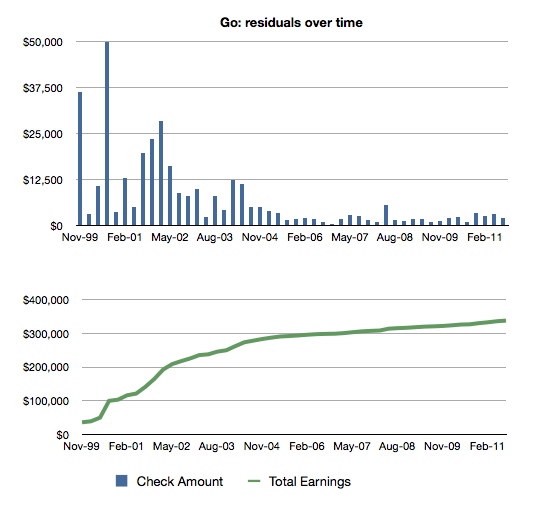Q&A: Who Gets Credit For A Screenplay? And What's The Deal With The Ampersands And Ands?
This is the first edition in a new regular series where I attempt to answer your questions about the film industry. We'll be taking a look at the box office, forgotten Hollywood landmarks, the marketing process and more. Sometimes I'll attempt to answer the question myself, and other times I will contact experts in the particular field to give a more detailed answer. Please feel free to send your questions to orfilms@gmail.com. I decided to start off this series with an easier question, and use it as a jumping-off point to delve into the more complex world of screen credits.
AND and &
The first question I saw on Twitter from my friend NewBeverlyJulia:
So on the Tintin posters it has Steven Moffat AND @edgarwright but Edgar Wright & Joe Cornish. Why does 1 get an "AND" and the other a "&"?
The answer to that specific question is pretty simple:
The word AND is used when two screenwriters worked separately, and the ampersand (&) is used when screenwriters worked as a team. In the case of Tintin, Steven Moffat finished a first draft of the script in 2007, before the Writers Guild of America strike. Moffat become executive producer of Doctor Who as the strike came to a halt leading Spielberg and Jackson to find writers to write additional drafts. Edgar Wright and Joe Cornish worked as a team on those drafts. While the basic story structure remained close to Moffat's initial draft, Wright and Cornish added enough to also earn credit on the production.
The Complicated World of Screenplay Credits
The world of screen credits can be very complicated because of the financial rewards. While writers are paid per assignment, a credit on the final film could mean a lot of money in residuals. Residuals can add up, even with a small movie — below is a look at the residuals for the John August scripted movie Go.
 Who Gets Credit?
Who Gets Credit?
The screenwriters union Writers Guild of America rules over arbitration, and they have a complex 27-page manual just on the subject of screen credits. Story or screenplay credits can not be shared by more than two writers, "except that in unusual cases, and solely as the result of arbitration, the names of three writers or the names of writers constituting two writing teams may be used." In the rules, "a team of writers is treated in all respects as a single writer." And to get credit, a writer must contribute a certain percentage of the finished work:
Any writer whose work represents a contribution of more than 33% of a screenplay shall be entitled to screenplay credit, except where the screenplay is an original screenplay. In the case of an original screenplay, any subsequent writer or writing team must contribute 50% to the final screenplay.
So if screenplay credits go into arbitration the WGA must try to determine these percentages, which is not done "by counting lines or even the number of pages to which a writer has contributed." Instead:
Arbiters must take into consideration the following elements in determining whether a writer is entitled to screenplay credit: dramatic construction; original and different scenes; characterization or character relationships; and dialogue.
Some big studio productions involve dozens of writers, and if the project gets made, it isn't uncommon for writers to fight for credit even on a clearly horrible film — remember, it's all about the residuals. For example, the 2004 Catwoman movie starring Halle Berry had 28 writers involved and 10 or so writers in the arbitration. The Writers Guild of America ultimately awarded screenplay credit to John D. Brancato, Michael Ferris, and John Rogers, and story credit to Theresa Rebeck, Brancato, and Ferris. Rogers has written a lot about the arbitration process on his blog.
Terminator: Salvation McG made a big deal about Christopher Nolan's brother Jonathan Nolan working on rewrites of Terminator: Salvation while the film was in production, but Nolan was not credited on the final film. McG claimed that he has "never met Michael Ferris and John D. Brancato, who ultimately got credit, and I thought we [Nolan] changed the script a great deal. ... It's not like the Ferris and Brancato draft deserved that writing credit. I credit Jonah as the architect of the picture, and I'm certain Christian [Bale] feels the same way. He represents the hard time on the ground in Albuquerque, N.M., when we shot the film and really got it going." Again, Nolan's missing credit is probably not because he didn't want to be associated with the resulting movie, but likely the result of WGA arbitration.Creating a New Muppet
McG made a big deal about Christopher Nolan's brother Jonathan Nolan working on rewrites of Terminator: Salvation while the film was in production, but Nolan was not credited on the final film. McG claimed that he has "never met Michael Ferris and John D. Brancato, who ultimately got credit, and I thought we [Nolan] changed the script a great deal. ... It's not like the Ferris and Brancato draft deserved that writing credit. I credit Jonah as the architect of the picture, and I'm certain Christian [Bale] feels the same way. He represents the hard time on the ground in Albuquerque, N.M., when we shot the film and really got it going." Again, Nolan's missing credit is probably not because he didn't want to be associated with the resulting movie, but likely the result of WGA arbitration.Creating a New Muppet
And things can become even more confusing when it comes to credits in sequels and adaptations. Here is an extreme example: Jason Segel co-wrote The Muppets with his writing partner Nicolas Stoller. In the script, Walter is described only as "the adopted younger brother of Mr. Segel's character. Walter isn't a little kid — he's about 30 — but looks like one. " The New York Times even details how the Puppet Heap Workshop created the look and design of Walter, not the screenwriters. When I was on set of the film we asked Segel if he created the new Everypuppet. His first response was "We invented Walter." But when we probed further about how long the design process took, we got a more interesting answer:
"We did not get to design him physically, because then they would owe us a lot of money. So we came up with him on paper, and then they were very clear that we could not be involved in any aspect of the physical design of Walter. But it is pretty crazy when I saw him and I knew that he was born in our brain. It's like Nick and I had a little baby with our brains! It's pretty crazy."
Will a Muppet movie in 20 years that uses Walter as a side character require that Segel and Stoller get a "Based on Characters Created by" credit (and the WGA-required residuals that accompany that credit)? I'm not sure. It is unclear if they were left out of the design process due to merchandise residuals (very likely) or if its to avoid ownership of the character in the franchise.
One thing is for sure: As long as screen credits are used to determine possible future residuals and unions are involved, it will remain a complicated process.
